2009 年中国矿业大学考博英语真题
提示:写在答题纸上,写在试卷上无效。
Part One: cloze (15 points)
Directions: Fill each of the blanks in the passage with one suitable word.
(1)
(4)
(2)
(3)
the problem is, however, this is not as easy
Solving a problem can be broken into several steps. First, the problem must be identified
correctly. Psychologists refer
this step as problem representation. For many problems,
figuring
which information is relevant and which is extraneous can be difficult and can
interfere
arriving at a good solution. Clearly, before a problem can be solved, it
must be obvious
it might seem.
One obstacle to efficient problem representation is functional fixedness, that is, allowing
preconceived notions and even prejudices to color the facts. Moat people tend
see
objects and events in certain fixed ways, and by being inflexible in viewing the problem, they
may be unable to notice the tools
the solution. Once the problem is identified accurately,
considering the alternatives for a solution.
(8)
A common way to evaluate alternatives is to write them
(11)
advantages and disadvantages for each solution. Here again, people may be limited by prior
lead them to the same problem-solving
experiences. Often people adopt mental sets
the past. Although that can be helpful
strategies that were successful for problems
most
the time, sometimes anew situation requires a different strategy.
(15)
that case, the mental set must be abandoned, and new alternatives must be explored.
, the second step consists
(10)
and then make a list
(7)
(9)
(5)
(6)
(14)
(12)
(13)
Part Two: Reading Comprehension (40 points)
Passage One
Questions 1 to 5 are based on the following passage.
Many of the most flexible examples of tool use in animals come from primates (the order that
includes humans, apes, and monkeys). For example, many wild primates use objects to threaten
outsiders. But there are many examples of tool use by other mammals, as well as by birds and
other types of animals.
Tools are used by many species in the capture or preparation of food. Chimpanzees use sticks
and poles to bring out ants and termites from their hiding places. Among the most complex tool
use observed in the wild is the use of stones by Ivory Coast chimpanzees to crack nuts open.
They select a large flat stone as an anvil (a heavy block on which to place the nuts) and a smaller
stone as a hammer. Stones suitable for use as anvils are not easy to find, and often a chimpanzee
may carry a haul of nuts more than 40 meters to find a suitable anvil. The use of tools in
chimpanzees is especially interesting because these animals sometimes modify tools to make them
better suited for their intended purpose. To make a twig more effective for digging out termites,
for example, a chimp may first strip it of its leaves.
Surprisingly, there is also a species of bird that uses sticks to probe holes in the search
for insects. One of the species of Galapagos finch, the woodpecker finch, picks up or breaks
off a twig, cactus spine, or leaf stem. This primitive tool is then held in the beak and used
to probe for insects in holes in trees that the bird cannot probe directly with its beak. Birds
have been seen to carry twigs from tree to tree searching for prey.
Tools may also be used for defense. Hermit crabs grab sea anemones with their claws and use
them as weapons to repel their enemies. Studies have demonstrated that these crabs significantly
improve their chances against predators such as octopus by means of this tactic. Also, many
species of forest-dwelling primates defend themselves by throwing objects, including stones,
at intruders.
�
1. What does the passage mainly discuss?
A. Primates are superior to other animals in using tools.
B. The use of stones as tools is similar across different animal species.
C. Birds and primates use tools that are different from those of sea animals.
D. Many animals have developed effective ways of using tools.
2. According to the passage, Ivory Coast chimpanzees are among the most remarkable of animal
tool users because they
.
A. use tools to gather food
B. use more than one tool to accomplish a task
C. transport tools from one place to another
D. hide their tools from other animals
3. Which of the following can be inferred from the passage about the behavior of the woodpecker
finch?
A. It uses its beak as a weapon against its enemies.
B. It uses the same twig to look for food in different trees.
C. It uses twigs and leaves to build its nest.
D. It avoids areas where cactus grows.
4. According to the passage, studies have shown that hermit crabs manage to turn octopus away
by
.
A. attacking the octopus with their claws
B. using stones as weapons
C. defending themselves with sea anemones
D. hiding under sea plants
5. Forest primates and certain sea animals are mentioned in the passage as examples of animals
that use tools EXCEPT for
.
A. self-protection
B. food preparation
C. hunting prey
D. building nests or home.
Passage Two
Questions 6 to 10 are based on the following passage.
Printmaking is the generic term for a number of processes, of which woodcut and engraving
are two prime examples. Prints are made by pressing a sheet of paper (or other material) against
an image-bearing surface to which ink has been applied. When the paper is removed, the image
adheres to it, but in reverse.
The woodcut had been used in China from the fifth century A.D. for applying patterns to
textiles. The process was not introduced into Europe until the fourteenth century, first for
textile decoration and then for printing on paper. Woodcuts are created by a relief process;
first, the artist takes a block of wood, which has been sawed parallel to the grain, covers it
with a white ground, and then draws the image in ink. The background is carved away, leaving
the design area slightly raised. The woodblock is inked, and the ink adheres to the raised image.
It is then transferred to damp paper either by hand or with a printing press.
Engraving, which grew out of the goldsmith's art, originated in Germany and northern Italy
in the middle of the fifteenth century. It is an intaglio process (from Italian intagliare, "to
carve"). The image is incised into a highly polished metal plate, usually copper, with a cutting
instrument, or burin. The artist inks the plate and wipes it clean so that some ink remains in
the incised grooves. An impression is made on damp paper in a printing press, with sufficient
pressure being applied so that the paper picks up the ink.
Both woodcut and engraving have distinctive characteristics. Engraving lends itself to
subtle modeling and shading through the use of fine lines. Hatching and cross-hatching determine
the degree of light and shade in a print. Woodcuts tend to be more linear, with sharper contrasts
between light and dark. Printmaking is well suited to the production of multiple images. A set
of multiples is called an edition. Both methods can yield several hundred good-quality prints
�
before the original block or plate begins to show signs of wear. Mass production of prints in
the sixteenth century made images available, at a lower cost, to a much broader public than before.
6. What does the passage mainly discuss?
A. The origins of textile decoration
B. The characteristics of good-quality prints
C. Two types of printmaking
D. Types of paper used in printmaking
7. The author's purposes in paragraph 2 is to describe
A. the woodcuts found in China in the fifth century
B. the use of woodcuts in the textile industry
C. the process involved in creating a woodcut
D. the introduction of woodcuts to Europe
8. The word "incised" in line 15 is closest in meaning to
.
.
A. burned
B. cut
C. framed
D. baked
9. According to the passage, what do woodcut and engraving have in common?
A. Their designs are slightly raised.
B. They achieve contrast through hatching and cross-hatching.
C. They were first used in Europe.
D. They allow multiple copies to be produced from one original.
10. According to the passage, all of the following are true about prints EXCEPT that
they
.
A. can be reproduced on materials other than paper
B. are created from a reversed image
C. Show variations between light and dark shades
D require a printing press
Passage Three
Questions 11 to 15 are based on the following passage.
In Death Valley, California, one of the hottest, most arid places in North America, there
is much salt,and salt can damage rocks impressively. Inhabitants of areas elsewhere, where
streets and highways are salted to control ice, are familiar with the resulting rust and
deterioration on cars. That attests to the chemically corrosive nature of salt, but it is not
the way salt destroys rocks. Salt breaks rocks apart principally by a process called crystal
prying and wedging. This happens not by soaking the rocks in salt water, but by moistening their
bottoms with salt water. Such conditions exist in many areas along the eastern edge of central
Death Valley. There, salty water rises from the groundwater table by capillary action through
tiny spaces in sediment until it reaches the surface.
Most stones have capillary passages that suck salt water from the wet ground. Death Valley
provides an ultra-dry atmosphere and high daily temperatures, which promote evaporation and the
formation of salt crystals along the cracks or other openings within stones. These crystals grow
as long as salt water is available. Like tree roots breaking up a sidewalk, the growing crystals
exert pressure on the rock and eventually pry the rock apart along planes of weakness, such as
banding in metamorphic rocks, bedding in sedimentary rocks, or preexisting or incipient fractions,
and along boundaries between individual mineral crystals or grains. Besides crystal growth, the
expansion of halite crystals (the same as everyday table salt) by heating and of sulfates and
similar salts by hydration can contribute additional stresses. A rock durable enough to have
withstood natural conditions for a very long time in other areas could probably be shattered
into small pieces by salt weathering within a few generations.
The dominant salt in Death Valley is halite,or sodium chloride, but other salts, mostly
carbonates and sulfates, also cause prying and wedging, as does ordinary ice. Weathering by a
variety of salts, though often subtle,is a worldwide phenomenon. Not restricted to arid regions,
�
intense salt weathering occurs mostly in salt-rich places like the seashore,near the large saline
lakes in the Dry Valleys of Antarctica, and in desert sections of Australia, New Zealand, and
central Asia.
11. What is the passage mainly about?
A. The destructive effects of salt on rocks.
B. The impressive salt rocks in Death Valley.
C. The amount of salt produced in Death Valley.
D. The damaging effects of salt on roads and highways.
12.In lines 13-17, why does the author compare tree roots with growing salt crystals?
A. They both force hard surfaces to crack.
B. They both grow as long as water is available.
C. They both react quickly to a rise in temperature.
D. They both cause salty water to rise from the groundwater table.
13. The word "shattered" in line 20 is closest in meaning to
.
A. arranged
B. dissolved
C. broken apart
D. gathered together
14. According to the passage, which of the following is true about the effects of salts on rocks?
A. Only two types of salts cause prying and wedging.
B. Salts usually cause damage only in combination with ice.
C. A variety of salts in all kinds of environments can cause weathering.
D. Salt damage at the seashore is more severe than salt damage in Death Valley.
15. Which of the following can be inferred from the passage about rocks that are found in areas
where ice is common?
A. They are protected from weathering.
B. They do not allow capillary action of water.
C. They show similar kinds of damage as rocks in Death Valley.
D. They contain more carbonates than sulfates.
Passage Four
Questions 16 to 20 are based on the following passage.
As a wise man once said,we are all ultimately alone. But an increasing number of Europeans
are choosing to be so at an ever earlier age. This isn't the stuff of gloomy philosophical
contemplations, but a fact of Europe's new economic landscape, embraced by sociologists,
real-estate developers and ad executives alike. The shift away from family life to solo lifestyle,
observes a French sociologist, is part of the “irresistible momentum of individualism” over
the last century. The communications revolution,the shift from a business culture of stability
to one of mobility and the mass entry of women into the workforce have greatly wreaked havoc
on(扰乱) Europeans,private lives.
Europe's new economic climate has largely fostered the trend toward independence. The current
generation of home-aloners came of age during Europe's shift from social democracy to the sharper,
more individualistic climate of American style capitalism. Raised in an era of privatization
and increased consumer choice, today's tech-savvy(精通技术的)workers have embraced a free market
in love as well as economics. Modern Europeans are rich enough to afford to live alone, and
temperamentally independent enough to want to do so.
professionals
Once upon a time , people who lived alone tended to be those on either side of
marriage-twentysomething
pensioners,
particularly elderly women, make up a large proportion of those living alone,the newest crop
of singles are high earners in their 30s and 40s who increasingly view living alone as a lifestyle
choice. Living alone was conceived to be negative-dark and cold, while being together suggested
warmth and light. But then came along the idea of singles. They were young, beautiful, strong!
Now, young people want to live alone.
citizens.
While
or
widowed
senior
�
The booming economy means people are working harder than ever. And that doesn't leave much
room for relationships. Pimpi Arroyo, a 35-year-old composer who lives alone in a house in Paris,
says he hasn't got time to get lonely because he has too much work. “I have deadlines which
would make life with someone else fairly difficult.” Only an Ideal Woman would make him change
his lifestyle, he says. Kaufmann, author of a recent book called “The Single Woman and Prince
Charming," thinks this fierce new individualism means that people expect more and more of mates,
so relationships don't last long-if they start at all. Eppendorf, a blond Berliner with a deep
tan, teaches grade school in the mornings. In the afternoon she sunbathes or sleeps, resting
up for going dancing. Just shy of 50, she says she'd never have wanted to do what her mother
did-give up a career to raise a family. Instead, "I've always done what I wanted to do: live
a self-determined life.”
16. More and more young Europeans remain single because
.
A. they are driven by an overwhelming sense of individualism
B. they have entered the workforce at a much earlier age
C. they have embraced a business culture of stability
D. they are pessimistic about their economic future
17. What is said about European society in the passage?
A. It has fostered the trend towards small families.
B. It is getting closer to American-style capitalism.
C. It has limited consumer choice despite a free market.
D. It is being threatened by irresistible privatization.
18. According to Paragraph 3, the newest group of singles are
.
A. warm and lighthearted
C. negative and gloomy
B. on either side of marriage
D. healthy and wealthy
19. The author quotes Eppendorf to show that
.
A. some modern women prefer a life of individual freedom .
B. the family is no longer the basic unit of society in present-day Europe
C. some professional people have too much work to do to feel lonely
D. most Europeans conceive living a single life as unacceptable
20. What is the author's purpose in writing the passage?
A. To review the impact of women becoming high earners.
B. To contemplate the philosophy underlying individualism.
C. To examine the trend of young people living alone.
D. To stress the rebuilding of personal relationships.
Passage Five
Questions 21 to 25 are based on the following passage.
Every group has a culture, however uncivilized it may seem to us. To the professional
anthropologist, there is no intrinsic superiority of one culture over another, just as to the
professional linguist, there is no intrinsic hierarchy among languages.
People once thought of the languages of backward groups as undeveloped. While it if possible
that language in general began as a series of grunts and groans, it is a fact established by
the study of "backward" languages that no spoken tongue answers that description today. Most
languages of uncivilized groups are, by our most severe standards, extremely complex. They differ
from Western languages not in their sound patterns or grammatical structures, which usually are
fully adequate for all language needs, but only in their vocabularies, which reflect the objects
and activities known to their speakers. Even in this aspect, two things are to be noted. First,
all languages seem to possess the machinery for vocabulary expansion, either by putting together
words already in existence or by borrowing them from other languages and adapting them to their
own system. Second, the objects and activities requiring names and distinctions in "backward"
languages, while different from the West, are often surprisingly numerous and complicated. A
Western language distinguishes merely between two degrees of remoteness ("this" and "that").
But some languages of the American Indians distinguish between what is close to the speaker,
�
or to the person addressed, or removed from both, or out of sight, or in the past, or in the
future.
21. Every group of human beings has
.
A. its own set of ideas, beliefs and ways of life
B. an extremely complex and delicate language
C. its own elegant music, literature, and other arts
D. the process of growing crops or raising animals
22. "Backward" languages fall behind Western languages in
.
A. ways to transfer ideas
B. forms to satisfy needs
C. abilities to answer description
D. systems to expand vocabulary
23. All languages, whether civilized or not, have their own
.
A. ways to transfer ideas
B. forms to satisfy needs
C. abilities to answer description
D. systems to expand vocabulary
24. Which of the following statements is implied in the passage?
A. Anthropologists have nothing to do with linguists.
B. Linguists have nothing to do with anthropologists.
C. The study of languages casts light upon the study of cultures.
D. The study of cultures casts no light upon the study of languages.
25. The author's attitude shown in this passage toward "backward" languages is
.
A. restrained
B. subjective
C. objective
D. resolute
Passage Six
Questions 26 to 30 are based on the following passage.
The sun today is a yellow dwarf star. It is fueled by thermonuclear reactions near its center
that convert hydrogen to helium. The sun has existed in its present state for about 4 billion,
600 million years and is thousands of times larger than the Earth.
By studying other stars, astronomers can predict what the rest of the sun's life will be
like. About 5 billion years from now, the core of the sun will shrink and become hotter. The
surface temperature will fall. The higher temperature of the center will increase the rate of
thermonuclear reactions. The outer regions of the sun will expand approximately 35 million miles,
about the distance to mercury, which is the closest planet to the sun. The sun will then be a
red giant star. Temperatures on the earth will become too hot for life to exist.
Once the sun has used up its thermonuclear energy as a red giant, it will begin to shrink.
After it shrinks to the size of the earth, it will become a white dwarf star. The sun may throw
off huge amounts of gases in violent eruptions called nova explosions as it changes from a red
giant to a white dwarf.
After billions of years as a whiter dwarf, the Sun will have used up all its fuel and will
have lost its heat. Such a stat is called a black dwarf. After the Sun has become a black dwarf,
the earth will be dark and cold. If any atmosphere remains there, it will have frozen onto the
earth's surface.
26. What is the primary purpose of this passage?
A. To alert people to the dangers posed by the sun.
B. To discuss conditions on earth in the far future.
C. To present a theory about red giant stars,
D. To describe changes that the sun will go through.
.
27. It can be inferred from the passage that the sun
A. is approximately halfway through its life as a yellow dwarf
B. has been in existence for l0 billion years
C. is rapidly changing in size and brightness
D. will continue as a yellow dwarf for another 10 billion years
.
�
28. When the sun becomes a red giant, what will conditions be like on Earth?
A. Its atmosphere will freeze and become solid.
B. It will be enveloped in the expanding surface of the sun.
C. It will become too hot for life to exist.
D. It will be nearly destroyed by nova explosions.
29. According to the passage, which of the following best describes the sequence of stages that
the sun will probably pass through?
A. Yellow dwarf, white dwarf, red giant, black giant
B. Red giant, white dwarf, red dwarf, nova explosion
C. Yellow dwarf, red giant, white dwarf, black dwarf
D. White dwarf, red giant, black dwarf, yellow dwarf.
30. Which of the following best describes the tone of the passage?
A. Alarmed.
objective
B. Pessimistic.
C. Comic.
D.
Part Three Vocabulary and Structure (15 points)
Directions: There are 30 incomplete sentences in this part. For each sentence there are four
choices marked A, B, C and D. Choose the one that best completes the sentence.
1. The house was very quiet,
as it was on the side of a mountain.
A. isolated
B. isolating
C. being isolated
having been isolated
2. The American basketball team announced that they would not
A. yoke
B. yell
C. yield
first place to any team.
D.
D.
yearn
3. He said there was a great gap between the views expressed in the media and what
were thinking.
A. usual
B. general
C. normal
ordinary
4. Lincoln, who many regard as one of our great presidents, was often
reputation of telling good jokes.
A. bright
B. optimistic
C. gloomy
despite his
people
D.
D.
cheerful
5. The most familiar headache comes from
which might be caused in turn by exertion, or worry or stress.
tightness in the back, head and neck,
A. monopoly
B. muscle
C. murmur
D.
monster
6. An
for learning the kinds of things required at school.
test is a rough measure of a child's capacity for learning, particularly
A. proficiency
B. intelligence
C. psychology
D.
speed
7. Nobody in the company pays attention to his opinion, because what he has said is always
mere
.
A commonplace
B. common
C. ordinary
D.
homely
8. Jack's
in crucial but not often noted ways to desegregation.
of black music and performers into a mainstream art form contributed
A. transformation
B. assimilation
C. deviation
D.
diversion
9. He lived in a
money-worshiping society.
house, and for this reason he was easily accepted into his
�
A. shabby
B. ragged
C. dingy
D.
decent
10. Teenagers in the 1950s, who had to
and international tensions, scorned the sterile version of American life.
an increasingly atomized family life and domestic
A. injure
B. conjure
C. confront
inflow
11. The rain was so heavy that the man was wet to the skin; his whole body was
and trembling.
A. stiff
B. straight
C. steady
D.
D.
hard
12. Tom was totally
that he could have got an A.
when he received a C on the exam in history, for he was positive
A. elated.
B. frustrated
C. incited
D.
contented
13. Despite repeated
students' burdens, little has changed.
by educational authorities for concrete measures to reduce
A. directions
B. recommendations
C. advice
calls
14. Every day, many people come to visit the
of the old castle.
A. location
B. highland
C. site
D.
D.
desert
15. Many young people believe that war is stupid and unnecessary. To them, to lose one's life
on the battlefield is
.
B. futile
D.
D.
difference
A. glorious
courageous
16. The Browns lived in a
C. heroic
and comfortably furnished house in the suburbs.
A. confess
B. sufficient
C. wide
wretched
17. Arrogance and pride are similar in meaning, but there is a(n)
between them.
A. submerged
B. indecisive
C. indistinct
D.
subtle
18. The
scientist.
of electronic computers has opened up new ways of data analysis for the
A. advent
B. adverse
C. advert
D.
advise
19. The first sentence in this paragraph is
ways.
; it can be interpreted in "many
A. intricate
B. ambiguous
C. duplicated
D.
confused
20. Rumors are everywhere, spreading fear, damaging reputations, and turning calm situations
into
ones.
A. tragic
suspicious
21.
A. Promoting
B. vulnerable
C. turbulent
D.
the issue of slavery and race has been fundamental in America's development.
D.
B. Confronting
C. Conquering
Measuring
22. Obviously he has done a very terrible thing today, but
responsible in the criminal justice system.
, he can't be held
A. justifiably
B. legally
C. Reasonably
D.
understandingly
23. Success as
achievement.
by economic output bears no close relationship to human
�
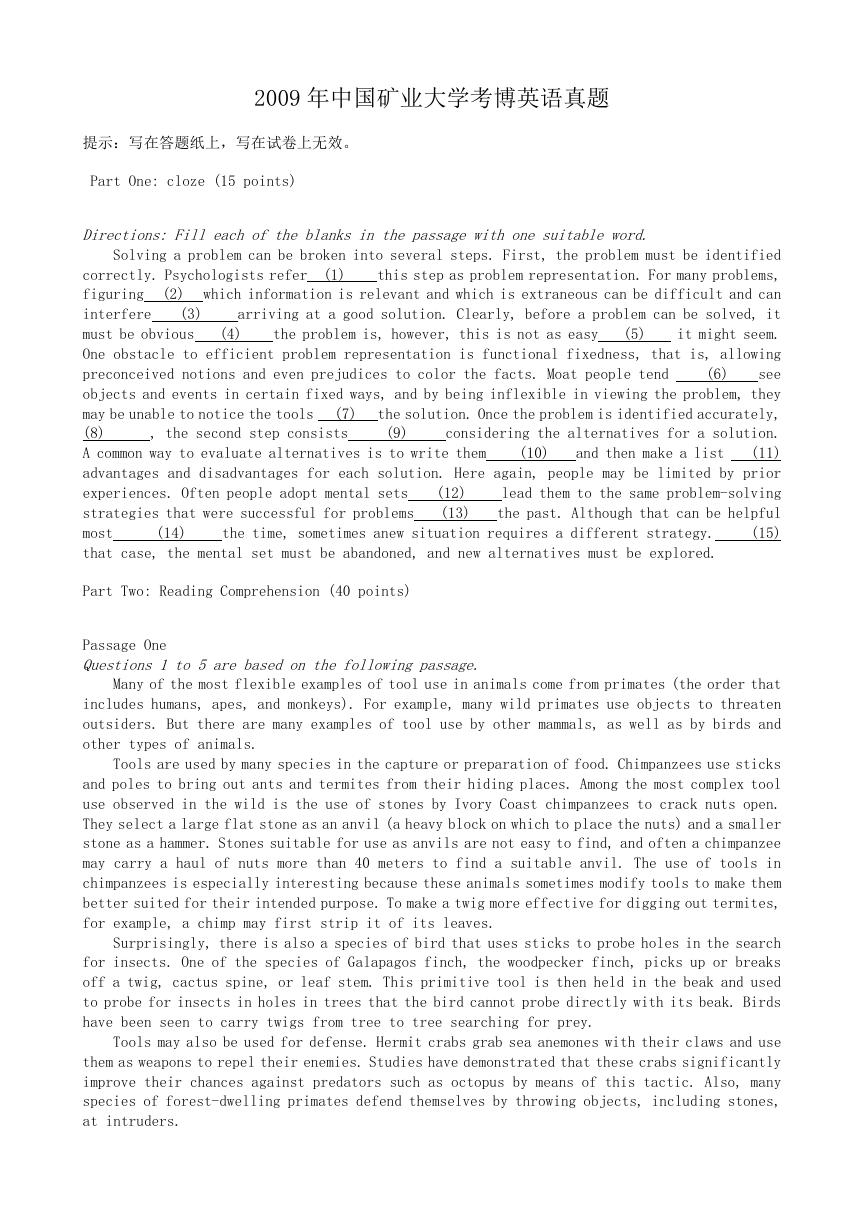


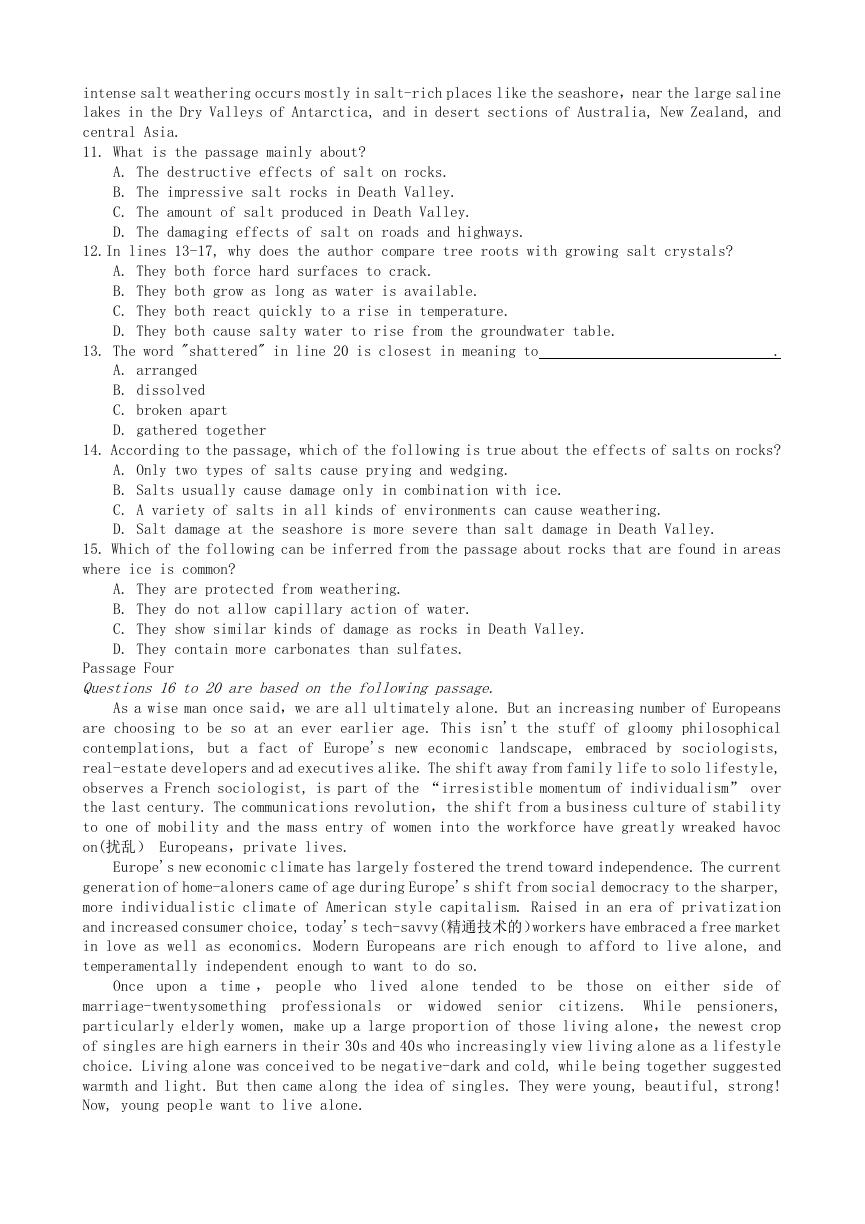
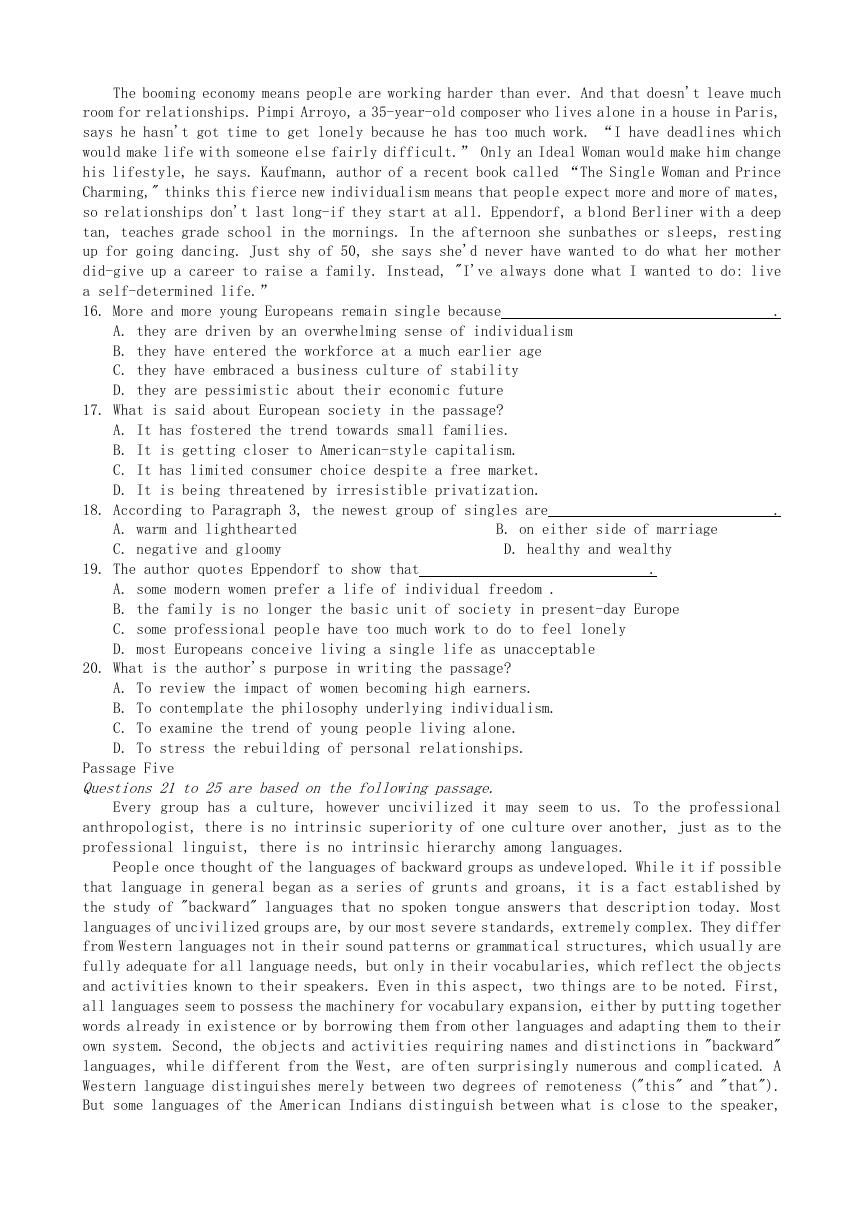
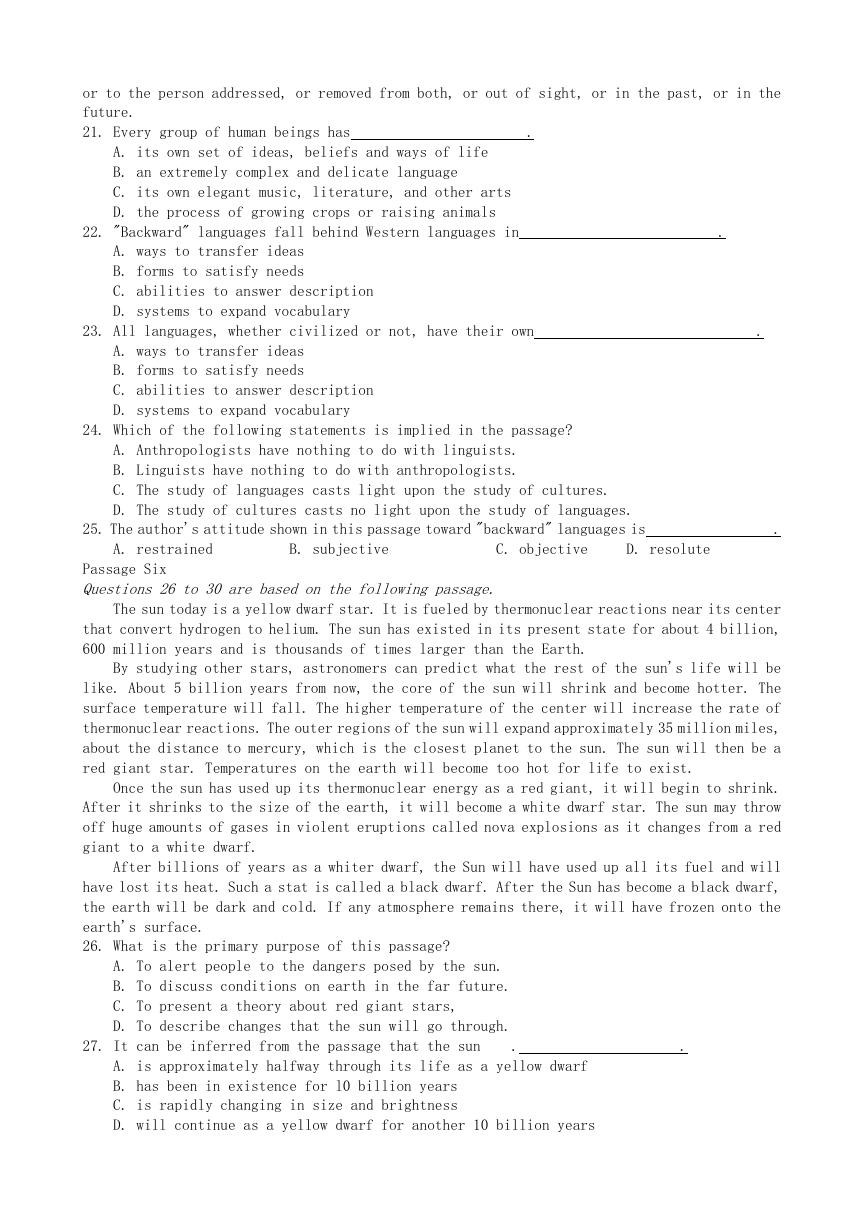

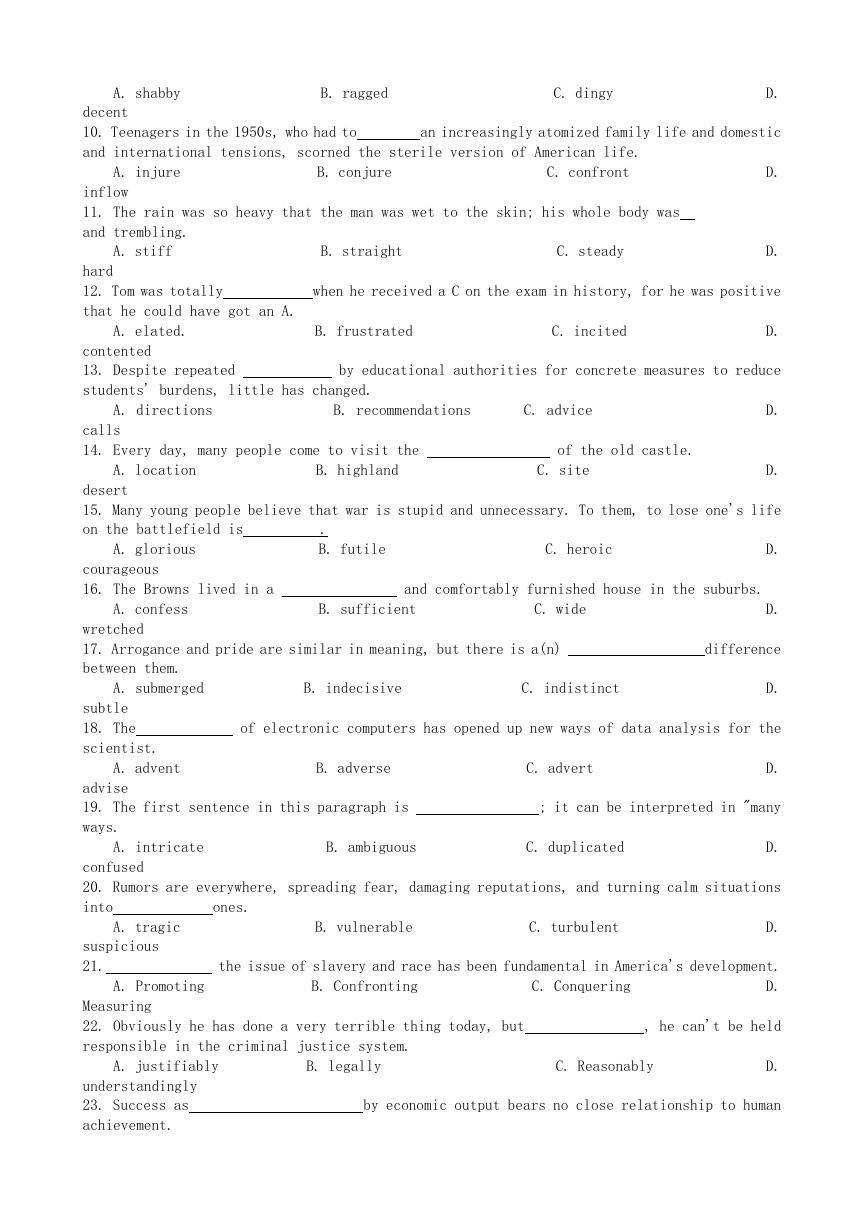








 2023年江西萍乡中考道德与法治真题及答案.doc
2023年江西萍乡中考道德与法治真题及答案.doc 2012年重庆南川中考生物真题及答案.doc
2012年重庆南川中考生物真题及答案.doc 2013年江西师范大学地理学综合及文艺理论基础考研真题.doc
2013年江西师范大学地理学综合及文艺理论基础考研真题.doc 2020年四川甘孜小升初语文真题及答案I卷.doc
2020年四川甘孜小升初语文真题及答案I卷.doc 2020年注册岩土工程师专业基础考试真题及答案.doc
2020年注册岩土工程师专业基础考试真题及答案.doc 2023-2024学年福建省厦门市九年级上学期数学月考试题及答案.doc
2023-2024学年福建省厦门市九年级上学期数学月考试题及答案.doc 2021-2022学年辽宁省沈阳市大东区九年级上学期语文期末试题及答案.doc
2021-2022学年辽宁省沈阳市大东区九年级上学期语文期末试题及答案.doc 2022-2023学年北京东城区初三第一学期物理期末试卷及答案.doc
2022-2023学年北京东城区初三第一学期物理期末试卷及答案.doc 2018上半年江西教师资格初中地理学科知识与教学能力真题及答案.doc
2018上半年江西教师资格初中地理学科知识与教学能力真题及答案.doc 2012年河北国家公务员申论考试真题及答案-省级.doc
2012年河北国家公务员申论考试真题及答案-省级.doc 2020-2021学年江苏省扬州市江都区邵樊片九年级上学期数学第一次质量检测试题及答案.doc
2020-2021学年江苏省扬州市江都区邵樊片九年级上学期数学第一次质量检测试题及答案.doc 2022下半年黑龙江教师资格证中学综合素质真题及答案.doc
2022下半年黑龙江教师资格证中学综合素质真题及答案.doc